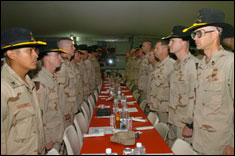 Scouts
from F Troop, 4th U.S. Cavalry, attend a spur dinner and induction
ceremony at Forward Operating Base Warhorse. The scouts were being
awarded their combat spurs July 29, a rite of passage for cavalrymen. Scouts
from F Troop, 4th U.S. Cavalry, attend a spur dinner and induction
ceremony at Forward Operating Base Warhorse. The scouts were being
awarded their combat spurs July 29, a rite of passage for cavalrymen.
Spc. David Dyer |
Cavalrymen earn their spurs
By Sgt. Kimberly Snow
September 13, 2004
BA'QUBAH, Iraq (Army News Service, Sept. 13,
2004) -- They strode in with a cowboy's swagger, many sporting the
distinctive black Stetsons that set them apart from their fellow Soldiers.
Scouts and guests of F Troop, 4th U.S. Cavalry Regiment gathered for a
dinner and ceremony July 29 to award the men their combat spurs -- an
event considered to be a rights of passage for cavalry scouts.
"It's an achievement to be accepted into the ranks of the brotherhood of
cavalrymen," said Troop 1st Sgt. Luther Lancaster. "It's a pride thing."
The ceremony, on Forward Operating Base Warhorse in Ba'qubah, Iraq, upheld
a tradition rooted in knighthood, where the awarding of gilt spurs
signified entry into the ranks and fraternity of the mounted warrior. A
squire would perform a task or deed on the battlefield or tournament field
in order to earn their spurs.
Today's cavalrymen earn their spurs in much the same manner. They can be
awarded to Soldiers serving in a combat zone, or in peacetime to Soldiers
who participate in a "Spur Ride" -- a series of tests and tasks led by a
spur-qualified non-commissioned officer, designed to test the candidates'
initiative, military expertise and endurance.
Each cavalry regiment defines its own criteria for awarding spurs, said
Lancaster, who first earned his spurs in 1987 with the 11th Armored
Cavalry Regiment. Anyone assigned or attached to a cavalry unit during
combat actions can also be authorized to wear the spurs, he added.
"There are always bragging rights with the spurs, who you earned them with
and where," he said.
Scouts who have earned their spurs prior to transferring to a new unit
will usually become honorary spur holders after completing a minimal
qualification, usually a written test on unit history, Lancaster said.
F Troop has set the criteria to include a minimum of three months in a
combat zone as well as having been in the vicinity -- 30 kilometers -- of
combat.
Only two men from F Troop have not yet earned their combat spurs -- only
because both have just arrived.
For Pfc. Joshua T. Hawkey, a 24-year-old scout from Tampa, Fla., with 19
months in service and first-time spur holder, the spurs symbolize
dedication and honor. Although he looks forward to earning his spurs with
another unit by completing a Spur Ride, said he feels that they have
earned them here.
"I feel privileged to have had the opportunity to have earned them and to
wear them," he said. "Hopefully I'm living up to the honor of it."
Both Hawkey and Lancaster said they were happy to see Soldiers who have
supported and been involved with the troop also earn the spurs. Among
those awarded them that night was Brigade Chaplain Maj. Chip Huey.
"The chaplain was in a couple of battles with us, went out on many patrols
with us, just the same as our commo guys or our supply guy," said
Lancaster. "He's brought a lot of inspiration to this troop since the
beginning."
The chaplain, who was present during one of the troop's fiercest battles
and also spent the night of June 24 with the troop when they secured a
stadium in Ba'qubah following an insurgent uprising, accompanies the men
on missions at least once week. He said he felt honored to be considered
part of their team.
"They are just a really unique collection of young men. They go out every
day, facing a significant amount of danger, and they face that danger with
panache and a grit that's really admirable," Huey said. "So for those of
us who are sort of part of their extended family, it's just a privilege to
be there with them and to be able to serve with them."
(Editor's note: Sgt. Kimberly Snow is assigned to the 196th Mobile Public
Affairs Detachment.) |

